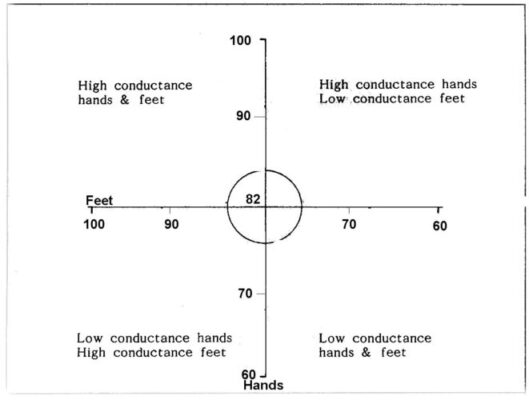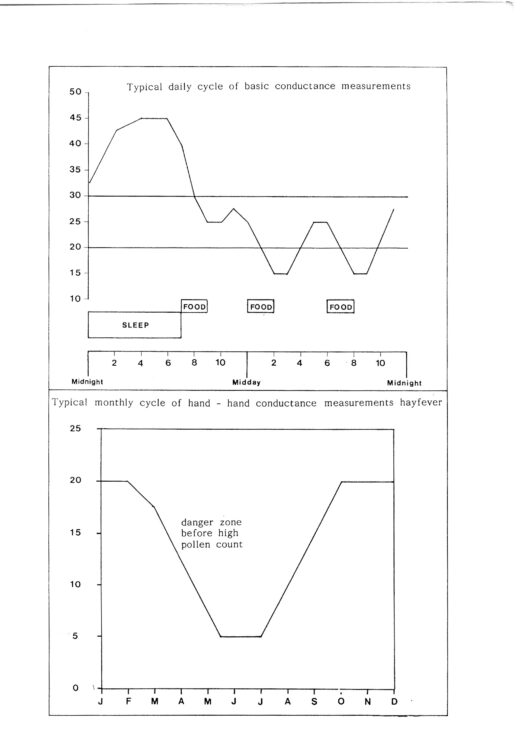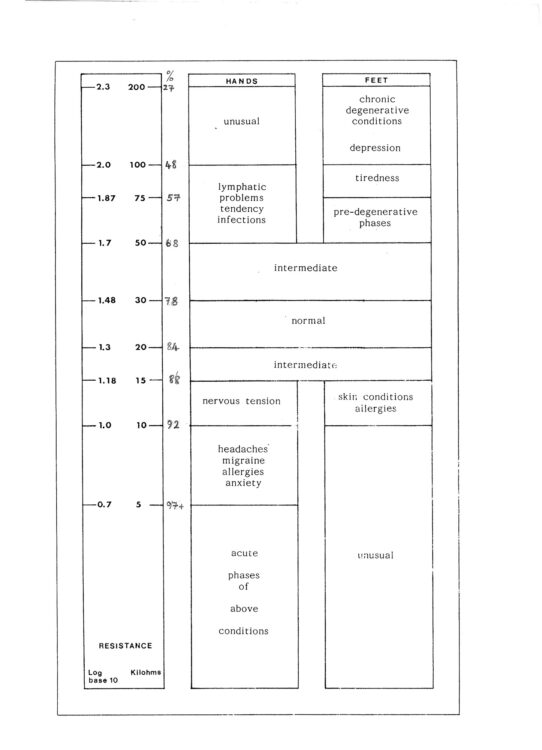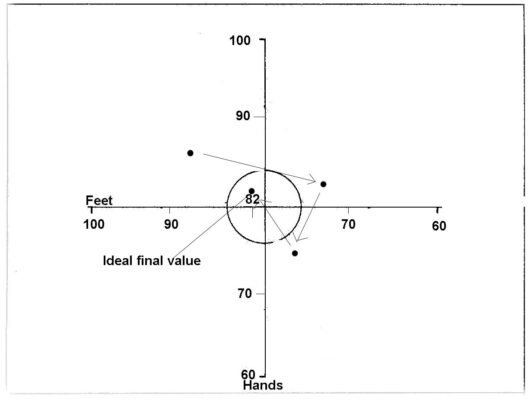When Carolyn invited me to write an article for ORIF I was very honored but left with the puzzle of what to contribute. Walter and Carolyn, together with OIRF staff have earned my respect over many years because of the wonderful job that they have done in bringing knowledge of biological medicine to so many people. Over a period of at least 35 years they have covered so much material that it is difficult to know where to start. On reflection I have decided to start at the beginning with a simple reproducible technique – the 4 quadrant measurement – that we all know about but so often overlook. This short contribution is aimed mainly at relative newcomers to biological measurement because I know that OIRF is especially interested in encouraging the beginner, but I hope that there will also be something of interest to more advanced practitioners.
Best wishes to all readers.
Quadrant measurement is one of the simplest (and most reproducible) measurements that we can take. The complete newcomer to MORA therapy can take quadrant measurements without difficulty because it does not involve any point measurement. Unfortunately, more advanced practitioners frequently omit or overlook the value of quadrant measurement in their haste to proceed with point evaluation. This is a great pity because we can make some quite interesting observations from quadrant data. The following notes are offered as a starting point. I do not claim these observations as hard fact but they have been gleaned from many years of practice. I would like to invite you to experiment with the following methodology and then to add to it or offer criticism according to your findings.
Please note that the measurement values quoted are approximations. The original values were taken in k-ohms and I have had to convert to the MORA measurement scale.
Using the scale measurement values the healthy range lies between 80 and 84.
Basic conductance should be considered as an approximate measurement that gives a guideline for treatment.
To obtain an accurate picture, the quadrant measurements should not be taken immediately after exercise or until an 1½ hours after an average meal. (A light meal is permissible).
False measurements will also result if they are taken immediately after patients have warmed themselves in front of a fire or radiator, or if taken immediately after lying down.
The moisture of the hands and feet should also be considered:
- If the patient has an excess of moisture on the hands or feet due to recent exercise or to the temperature of the room, the patient should relax for 10 minutes in a cooler place and the hands/feet should be wiped dry with a tissue.
- If the skin is extremely dry then it should be wetted with water and wiped dry with an absorbent tissue. Moist tissues can be used on the electrodes as an alternative.
- (Note: dry skin may be part of the energy imbalance. If moist electrodes are used then it is possible that all measurements will be on the high side but the proportions should remain the same.)
- With normal skin try taking the measurements on dry electrodes. Under normal conditions the hand/hand measurement should be 80 or higher.
If the electrodes are cold then false measurements will be returned. This will correct itself after about 30 seconds.
Quadrant Data
Based on large international samples of data the normal measurement range has been found to lie in the range 80 – 84 scale units. This equates to 20 – 30 k-ohms.
The lower the value (in scale units) is, the higher the resistance or low conductance. High scale values represent increased conductance or low resistance.
Values greater than 84 represent toxic irritation due to inflammations. Values lower than 78 represent fatigue due to degenerative conditions.
Generally, people who are ill will return values that lie some way out of the normal range. Between the normal range and the point where people seek medical attention there lies an intermediate range both above and below the normal range. Typically, these patients will not show clear symptoms but will suffer from a range of minor disorders.
A large number of disorders show patterns of measurement between the hands and feet (i.e. upper body and lower body). The most common pattern is when the hand/hand measurement is greater than 84 and the foot/foot measurement is less than 78.
It is usually quite easy to correct values that are high but less easy to correct values that are low.
If the hand/hand measurement is less than 78 then the patient is fatigued and in a parasympathetic state. Point measurement may be inaccurate if this value is low. Therefore every attempt should be made to build up the energy. If, after a number of treatments the low quadrant measurements do not improve then it is probable that no permanent improvement in the condition will result.
Investigation
Plot the measurement data graphically by making a graph where the horizontal axis represents the foot measurements, and the vertical axis represents the hand measurements. The scale should run from 100 – approx 60 (see example)

There are four sectors in the graph: top left; top right; bottom left; bottom right. Each sector represents different energy imbalances:
| A | Top left | Excess of energy throughout the body |
|---|---|---|
| B | To right | Excess of energy in the top half of the body; deficiency in the lower half of the body. |
| C | Bottom left | Deficiency in the top half of the body; excess in the lower half. |
| D | Bottom right | Deficiency of energy throughout the body. |
Preliminary Observations
Osteoarthritis and depression are characterised by moderate to severe deficiencies across the lower half of the body.
Anxiety, nervous tension, migraine tend to show excess energy in the top half of the body.
Skin conditions, asthma, and allergies are characterised by excess energy throughout the body.
(Note: Infantile asthma = high energy hands and feet; adult asthma = high energy hands; low energy feet.)
Basic Therapy and Quadrant Values
The importance of basic therapy cannot be over-emphasised. If treatment of a patient’s complaint is to be effective and long lasting then it is essential to bring the four body quadrants back into balance in the normal range. If this is not done then the effects of therapy are likely to be disappointing. It is like building a house without foundations.
Basic therapy goes some way to bringing about this balance. However, basic therapy alone will not rectify many quadrant imbalances but we can make some specific observations:
There is no change in quadrant values after basic therapy. This means that the energy is blocked. Consider TMJ dysfunction or the possibility of spin factors.
Sometimes after basic therapy all quadrants reduce in value, sometimes to values that lie in the low range (i.e. below 78). This probably indicates that the patient is in a temporary sympathetic state perhaps due to travel to the appointment or the nervous tension but when this is released they revert to a parasympathetic state. The low energy must be lifted before taking point measurements or before trying to give treatment. Do not test for medications when the energy is too low as false results will be obtained.
The other possibility is that the quadrants return to normal values. This is the ideal state but does not often happen until several therapy sessions have taken place.
Low Energy
A problem arises if the energy of the body is too low (<78). Point measurement is inaccurate because of the energy state. It is therefore important to raise the energy. Using the MORA instrument one can try to give a “basic” therapy using a setting of “A” (see tables of treatment for low energy and for low conductance). Unfortunately it has been the experience of the author that this is often not successful. The reason for this is that it will take time to replenish the energy reserves of the body. Better is to consider using moxa or electrical moxa.
Use moxa on point LI-4 (classical for low energy upper body) and/or point St-36 for low energy lower body. This will usually bring up the energy to a suitable range for further point measurement.
NB Do not give electrical moxa to patients with a known heart condition, pacemakers, or other electrical implants.
If the above suggested points are not successful then the “Seas of Energy” should be considered.
Cycles of Energy Variation
People in reasonable health (normal or intermediate zones) show variations in basic measurement on a daily cycle in the same manner as other physiological cycles.
People with quadrant measurements outside these values show relatively little variation on a daily cycle.
Seasonal illnesses show seasonal variation in quadrant measurements. For example, with hay fever, it has been found that the quadrant measurements can change up to six weeks before the onset of symptoms. This enables monitoring and prevention of the condition. Thus quadrant measurement is a useful means for monitoring health and for preventive therapy.
Note: The vertical axis is shown in k-ohms. For conversion to scale values see below.

The following graph shows the conversion from k-ohms to scale values together with measurement values that frequently arise.

Finally, do not be surprised if, during several treatment sessions, the quadrant values appear to deteriorate. It is not unusual to see the following progression:

The values often drop, particularly the foot-foot values; this then follows with a drop in all quadrants to finally build up to the ideal range.
 An Exclusive Article for Members
An Exclusive Article for Members
From THE BRIDGE Newsletter of OIRF
Published October 15, 2007
© Copyright 2007, Dr. Anthony J. Scott-Morley, UK



